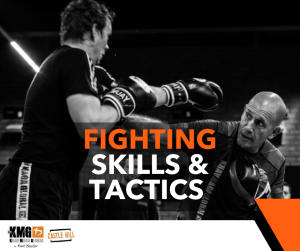The person who knows how to use tactics in a fight will win the battle – Eyal Yanilov

We can be made aware that self-defense is an important skill to have, but what’s often overlooked is the role of tactics in self-defense. Tactics are a key component of being able to effectively defend yourself due to their focus on strategic decision-making and ‘fighting smart’ rather than just ‘fighting hard.’ To understand how tactics play a role in self-defense, let’s explore what tactics are and how they can be applied to any confrontation.
–
What Are Tactics?
Tactics are defined as the art and science of disposing and maneuvering forces in combat. In other words, they refer to the specific strategies used by individuals or organizations during a confrontation. Below we will cover a few of the KMG tactics that we train our students in.
We divide the different tactics according to categories.
Here are a few short examples:
Fakes and Feints
– The main idea here is to fool our opponent. The goal is for him to move his attention and his resources to cover or protect this area, while exposing another. The real attack targets the exposed part. There are options to fake in direction, fake in height, fake in speed and fake with different limbs.
– The main idea here is to fool our opponent. The goal is for him to move his attention and his resources to cover or protect this area, while exposing another. The real attack targets the exposed part. There are options to fake in direction, fake in height, fake in speed and fake with different limbs.
Trapping
This category is a change of the posture and position of the enemy, to create an opening that will allow the targeting of the exposed area.
We have trapping, pulling or pushing, one hand while striking or kicking the exposed area. This can be the head or the lower ribs.
Example: trapping two hands, grab and move both hands (either cross one over the other or open sideways) of the enemy, while striking the exposed area, such as the groin or the head. Trapping can be of a leg too, this can cause a loss of balance and diversion of attention that leave the adversary exposed.
Breaking Corners
This fighting tactic is targeting less common areas such as the fingers, palms, knees or feet of the enemy. You can cause significant damage to certain areas of the body; however you can also use this as a disruption that will create an opening. If you manage to cause a lot of pain to the attacker, you can attract your enemy’s attention to that pain (through them using verbal communication). It can disrupt their attention and cause them to lose focus with a diminished will to fight.
Changes to Rhythm and Style
Assume that the enemy thinks that you are one kind of fighter, let’s say a kicker, and at a certain moment you change your way and fight like a grappler, rapidly closing the distance, lifting and throwing the enemy to the ground and kicking him. This is a big change in the way you operate and act. Or when you dance and bounce around the adversary, from time to time delivering a strike or a kick, avoiding any prolonged encounter. Then suddenly you burst directly towards him, closing the gap with double or triple simultaneous attacks, and continue with a fury of attacks at close range. With this surprising and confusing action it’s rather easy to overcome the situation.
Incorporate these methods into your training routine and see which works out best for you, but still make sure you mix it up every now and again, to become a more versatile and unpredictable fighter.
How Do Tactics Play A Role In Self-Defense and Fighting?
The use of tactical thinking can give someone a distinct advantage when it comes to defending themselves. Tactical decision-making emphasizes not just fighting hard but fighting smart – assessing the situation quickly and accurately so that one can make decisions that will lead to success. The goal is not just survival but also victory – being able to end the confrontation as quickly as possible with as little harm done as possible while successfully protecting yourself or others if necessary.
–
When it comes to self-defense, training in tactical skills is essential because most confrontations occur suddenly and without warning, meaning one must be able to think on their feet and react quickly based on their knowledge and experience with different types of tactical scenarios. This includes understanding how different types of weapons might come into play (such as easily accessible common makeshift weapons – scissors, bats, chairs etc) as well as recognizing pre-fight indicators (body language cues from opponents may indicate what type of attack may be coming or whether there are additional opponents present who could pose a threat. )
Knowing how to apply tactical thinking during a confrontation can mean the difference between success and failure for someone trying to defend themselves or others against attackers who have the upper hand. Understanding different types of tactics and how to implement them can help provide an individual with the knowledge they need to quickly assess their environment and make decisions that will keep them safe while also giving them an edge over their attacker/s if necessary. With this understanding comes greater confidence when faced with difficult situations, which can help ensure one has the best chance possible at successfully ending any confrontation they find themselves in on their own terms.
| Sign up for our starter programs and start training: https://www.kravmagaselfdefence.com.au/#join |


